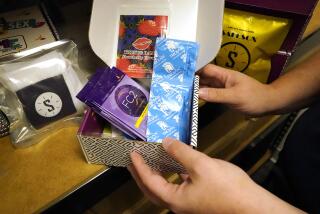Girl Talk: Sex as a Safe Topic : Relationships: An O.C. program for mothers and their preteen daughters is designed to make communication comfortable and open.
- Share via
When Erin Esses, 11, found out that her mother had signed her up for a human sexuality class, she wasn’t exactly thrilled. “The word that comes to mind is embarrassed, “ Erin says.
Then Erin discovered to her horror that her mother was taking the class with her. And if you’re a preteen girl like Erin, talking to your mother about sex can be even more embarrassingthan talking to a room full of strangers.
In this class, mothers and daughters would be discussing female and male anatomy, menstruation, pregnancy, masturbation, erections and wet dreams. No question would go unanswered. No topic would be taboo.
Even sex educators such as Leslie Dixon, who teaches the class, say that putting mothers and daughters together in a room to discuss such subjects can be awkward. “The mothers prefer to stay with the mothers and the daughters with the daughters,” says Dixon, who does not allow that to happen.
After all, the point of the program is to open up communication between mothers and daughters so that they can talk openly and knowledgeably about sex. When they attend classes together, they both receive factual information at the same time, using the same terms.
Most preteens are receiving their sex information from friends and the media, according to polls conducted by the Center for Population Options in Washington, D.C. The same study found that most adolescents would prefer to get such information from their parents.
And while nearly all parents say they would like to be the primary educators of sexuality for their children, only a small percentage actually do it, Dixon says.
The difficulty in communicating comes at a time when children often feel awkward and are in need of a close, reassuring relationship with their parents.
The five-week class Dixon teaches is called SHAPE--for Sharing Healthy Adolescent and Parent Experiences--and it is designed for mothers and their preteen daughters. (There’s a similar class for fathers and sons.) The program is offered by the Coalition for Children, Adolescents and Parents, an Orange-based nonprofit educational organization whose primary goal is to prevent unwanted teen-age pregnancies.
Classes, which cost $25 per mother-daughter couple, are presented to small groups that request them. A recent class was held in a private home in Irvine for members of a girls’ soccer team. Another program is planned in January at a Jewish temple and another at a women’s center.
The SHAPE program is patterned after a class run by the Family Guidance Center in St. Joseph, Mo. It presents age-appropriate information about puberty, the reproductive system, becoming a parent and resisting early sexual pressure. It is funded by a state grant and aimed at girls age 9 to 12. This age group is the target, Dixon says, because studies show that most people gain more than 80% of their knowledge about sex during those years.
Program participants such as recent graduates Erin Esses and her mother, Alison Mitchell of Mission Viejo, say that the class brought them closer together. Now that it’s over, even Erin admits: “I guess I was actually happy. I mean, I am now less scared about getting my period, and I’m prepared.”
She has also learned that she can talk openly to her mother about it and the other changes going on in her life.
Mitchell, a former physical education teacher who considered herself well-informed, says she learned a lot during the class. “Especially about young people today,” she says. “They did a couple of quizzes about things like teen-age pregnancy and what is the main choice of contraception. And also things about what are the largest influences on children’s lives. I also learned by the questions the kids asked. You can tell (from the questions) a lot about the misconceptions that are out there.”
Mitchell says that her relationship with her daughter has grown because of the increased communication between them.
“We do a lot of things together, but this brought us closer on a different level. She is getting older, and I remember vividly what it was like to be her age. It was nice to share that stuff with her. I feel at this age she has already got one foot out the door. Her peer influences are getting stronger and stronger. I want her to be able to come to me if she has questions or concerns, to be able to talk to me about it instead of basing a decision on a discussion with her peers.”
*
Once the subject is out in the open, parents and their children find it easier to talk about issues of sexuality, says Dixon, a former registered nurse who now specializes in family planning and parent education. “Most teen-agers want honest information, but that doesn’t necessarily mean that they are sexually active,” she said.
In fact, such information can better equip children to postpone sexual activity until they are ready. And the common base of information can make it easier for parents to offer guidance about behavior they consider appropriate and inappropriate as their children mature into adults.
While public schools offer students some sex education, their need for information is greater, Dixon said.
Sex education programs in Orange County public schools vary by district, but menstrual hygiene and puberty films are usually shown in the fifth and sixth grades, according to Sandy Landry, Health and Wellness Program administrator for the Orange County Department of Education. Parental permission is required to view the films. Education about AIDS is also required now, Landry said, with curriculum and content approved by each local school district.
During one of the recent SHAPE classes Dixon taught, most of the 10- and 11-year-old girls had seen the school film on menstruation. Still, some had trouble recognizing the word and were reluctant to talk about its meaning. But by the end of the evening, the girls had learned to identify their internal body parts and were racing to assemble puzzles depicting the location of the Fallopian tubes, the ovaries, the uterus and vagina.
*
“I think this is an awkward topic for mothers and daughters,” says Mitchell, who estimates that as a girl she received only about 10% of the information her daughter got in the class. She says the openness helps both mother and daughter feel more comfortable discussing sexuality.
“This opportunity is wonderful for those who have difficulty talking about it,” she says. “Being in a group situation helps. What’s nice about the class is there really aren’t any restrictions. I was impressed with the candidness of the questions the girls asked. I know there was no way I was going to ask a question like that when I was their age.”
Mitchell says that her daughter will be more likely now to go to her with questions. “There are still things left for us to talk about. I am hoping that when the pressure comes for her to be sexually active she will have enough courage to stand up for what she is comfortable with. I think that so many girls are talked into being sexually active before they are ready.”
For mother and daughter, the class becomes a “five-week bonding period,” Dixon says. “That is why we put them together even though they prefer to be separate. . . . It shows the daughters that mothers are accessible. That they can always go home and talk.
“For them to have this information in a healthy, correct way and to start communicating with their mother--that is going to influence whether or not they are going to become sexually involved in junior high and high school. At this age they haven’t made that decision yet.”
For information on the SHAPE program or other information about parents talking to their children about sexuality, contact the Coalition for Children, Adolescents and Parents at (714) 972-4859.


